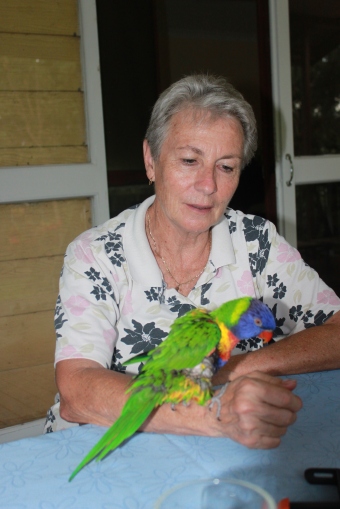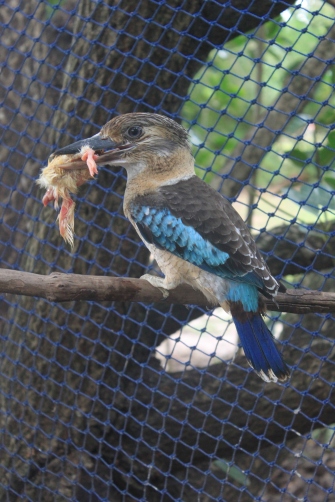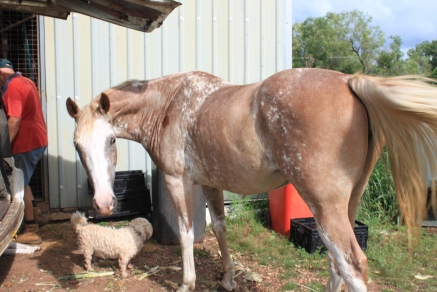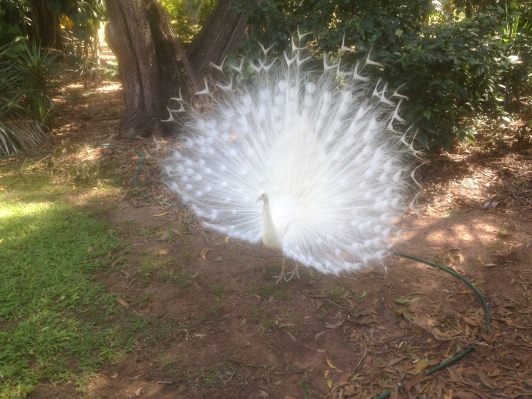Just southeast of where we live in Zuccoli lie the communities of Coolalinga and Virginia where you will find miles and miles of scenic country roads weaving around through the lush countryside. As you drive down these roads, you can occasionally catch a glimpse of a home set back in the trees, or at the back of a lush expanse of grass. These larger tracts of land are all privately owned and fenced, with various types and styles of gates blocking their entrance.
 One particular gate in Virginia, however, was designed to contain rather than exclude. Behind it lay a host of animals, both free and restrained within coops, cages, fences, and even held within beanie hats. When it comes to all the animal lovers we have known or heard of, Barb and Herb Backers of Colliwobble Farm near Coolalinga (I love to say that!) top the list.
One particular gate in Virginia, however, was designed to contain rather than exclude. Behind it lay a host of animals, both free and restrained within coops, cages, fences, and even held within beanie hats. When it comes to all the animal lovers we have known or heard of, Barb and Herb Backers of Colliwobble Farm near Coolalinga (I love to say that!) top the list.
 We first met the Backers on Boxing Day last month when our missionary zone went to their farm to do service for the afternoon. Barb provided a wonderful lunch, and then we all went to work, weeding, cutting out dead bamboo canes (that must have been 30-40′ tall) putting together a car port, packaging powdered kangaroo formula, and picking coconuts. This is the group, very tired and sweaty, at the end of the activity.
We first met the Backers on Boxing Day last month when our missionary zone went to their farm to do service for the afternoon. Barb provided a wonderful lunch, and then we all went to work, weeding, cutting out dead bamboo canes (that must have been 30-40′ tall) putting together a car port, packaging powdered kangaroo formula, and picking coconuts. This is the group, very tired and sweaty, at the end of the activity.
Herb and Barb had to have been a match made in heaven to be able to be so united in such a venture – one requiring such a great deal of their time, energy and resources. Barb has to get up through the night to feed orphaned baby animals, and also has to take them with her to church and sometimes to work to accommodate their frequent feedings. They buy frozen, dead baby chickens 5,000 at a time to feed all the meat-eating birds they care for, such as kookaburras, owls and eagles. They buy powdered baby wallaby formula in bulk, dividing it into smaller packages so they can provide it at a greatly reduced price to other animal care givers in their organization.
 Barb & Herb Backers, Sister Buckner & Elder Buckner at Colliwobble Farm
Barb & Herb Backers, Sister Buckner & Elder Buckner at Colliwobble Farm
Herb, who builds roads by trade, builds fences, pens, cages and shelters at home. He drives to a grocery store six days a week to collect big wheelie bins full of discarded produce which he loads with a fork lift into his truck. It is saved by the store to feed their animals and the hundreds of tame and wild magpie geese that live on their property and hang out around the stream that runs through it. Barb picks up a huge load of donated day-old bread (bread doesn’t keep long in this climate) every Friday night from a local bakery to feed their geese. The geese come by the hundreds along with flocks of little corellas (a type of cockatoo) for the daily evening feast this donated bread provides.


One very talented lorikeet! Barb also has a pet lorikeet – a very beautiful and colorful bird that is abundant in the wild, here. Although we suspect Talulah is really a boy, the name has stuck. (It takes a DNA test for us humans to tell, although the wild lorikeets don’t seem to have a problem telling the difference.) Talulah has been with Barb for about 2 years. She was dropped off by a woman who was going to be out of town for a number of months. The woman didn’t trust the bird with a member of her family, because they had a cat. “But I have THREE cats! protested Barb. The bird stayed anyway, and although the woman did come by once to visit, she never took Talulah back home. Talulah talks a blue streak, saying things like, “I want some yum-yum,” “Charlie,” “Come-‘ere,” and “Hello, Babe” (Barb loves hearing that one when she gets up in the middle of the night to feed all her babies).” She always says “thank-you” after being fed. Her food is served warm, and sometimes she says “Hot! Hot!” when she receives it, and then says, “Oh, that’s really good!” when eating. Tulula also laughs, and sometimes mimics the ring on Barb’s phone so well, you can’t tell the difference.
Knock, knock, who’s there? Included in the entire menagerie are 6 dogs, 3 cats, goldfish and catfish in a tank in the house, a horse, many ducks and chickens, 3 galahs, 9 kookaburras, 1 wild tree snake (we saw him while we were there), 1 pet twenty-two year old children’s python named Archie (who only eats small rodents), a number of wallabies, 2 walleroos, numerous peacocks and guinea hens, 2 cows (these are, too), a curlew, hundreds of geese and 3 emus. Many, if not most of these, are rescue animals that can’t be released back to the wild; those that can be rehabilitated are eventually released. The fences and gate are mainly to keep the emus in.
 9 Kookaburras! When Barb told us that their blue-winged kookaburras make a huge ruckus around 7PM before they settle down for the night, I was excited to go and hear them laugh, but apparently this kind doesn’t – it only squawks. Of the 9 in their large pen, 6 cannot be released due to things like broken or missing wings. Kookaburras are hunters or scavengers, and have a huge beak to enable them to swallow their food whole. Before they do, however, they have to break or beat it up a bit, often by slapping it against the branch they are sitting on. They have to be fed by an adult bird for a long time before they learn to do this. For them, Barb cuts the chicks into small pieces, holds the young birds upside down in a cloth on her lap, and pushes the pieces down their throat until they swallow. And she sits in their pen and does this even during the wet season, with rain pouring down on her.
9 Kookaburras! When Barb told us that their blue-winged kookaburras make a huge ruckus around 7PM before they settle down for the night, I was excited to go and hear them laugh, but apparently this kind doesn’t – it only squawks. Of the 9 in their large pen, 6 cannot be released due to things like broken or missing wings. Kookaburras are hunters or scavengers, and have a huge beak to enable them to swallow their food whole. Before they do, however, they have to break or beat it up a bit, often by slapping it against the branch they are sitting on. They have to be fed by an adult bird for a long time before they learn to do this. For them, Barb cuts the chicks into small pieces, holds the young birds upside down in a cloth on her lap, and pushes the pieces down their throat until they swallow. And she sits in their pen and does this even during the wet season, with rain pouring down on her.

One curlew. It was really surprising to see the injured curlew’s dinner. I couldn’t believe how much it eats! Incidentally, curlews are called “murder birds” by the Indigenous people in Australia. It’s not because the bird is dangerous; it is because the noise it makes sounds like someone is being murdered. 🙂 This bird will be released as soon as it mends. (And as of this posting, it has been released.) All of these animals have to be able to find and eat bush tucker (natural bush food) to be on their own. While there, we noticed that some of their former feathered friends occasionally come back at dinnertime asking for a handout, which is willingly provided.
 A horse named Willow. When we went looking for one of the emus (this is a big place), Willow decided to follow us. When we didn’t go fast enough, she’d nudge Pam Hinton, who was with us, in the back. Willow is also very curious. The day we were there, she had been let out of her pasture into the main part of the property, and had discovered where another animal’s food was stored and was eating it. She receives lots of fresh fruits and veggies in addition to the lush grass in her pasture, every day but Sunday, and apparently went looking for it. She is gentle enough to be ridden bareback with a halter, even by a child. Isn’t she beautiful?
A horse named Willow. When we went looking for one of the emus (this is a big place), Willow decided to follow us. When we didn’t go fast enough, she’d nudge Pam Hinton, who was with us, in the back. Willow is also very curious. The day we were there, she had been let out of her pasture into the main part of the property, and had discovered where another animal’s food was stored and was eating it. She receives lots of fresh fruits and veggies in addition to the lush grass in her pasture, every day but Sunday, and apparently went looking for it. She is gentle enough to be ridden bareback with a halter, even by a child. Isn’t she beautiful?

Emus, cows and all the rest. One of the Backer’s 6 dogs got too close to a nesting emu on their property (the male, who sits on the eggs and hatches them), and had his leg taken off as a puppy. Reaching six feet tall, it’s probably not wise to trifle with emus, nesting or not. Last time we were there, one emu almost let me hug it; this time we couldn’t even get close. The dogs all get wet in various livestock watering containers in an effort to stay cool, here in the tropics. Wonder how these 3 emus manage with all that thick plumage? It actually insulates them from the heat!



Now, after seeing all these animals, I had to ask Barb if they were vegetarians! How could someone who obviously loves animals so much eat meat? She replied that they are not, and do eat meat – just not meat from their own animals. They once had pigs that were raised for meat. Barb said with a smile that their pigs were “repackaged” and sold.

My favorite part of their farm is the big area where all the wallabies and walleroos are. I even have a favorite wallaby (see below) called Raafa. This little guy loves to be scratched

on his tummy, too, and will almost do a back bend in appreciation. Incidentally, most of the wallabies here are blind, and those that aren’t, have other infirmities. Raafa’s name comes from RAAFA – the Royal Australian Air Force Base where he was found. These animals come to Barb and Herb from all over the Northern Territory.

It is obvious that even those animals that are in large pens or cages are happy to have this be their “home sweet home.” When we passed the large cage where the galahs live, Herb demonstrated that they also talk, saying things like, “hello,” come here,” “and “bye-bye.” I might add that “bye-bye” often comes with a wave of their foot! The female was originally wild and often visited because she had a crush on their male; she ended up moving in to escape a predator, and has even hatched a chick since then. Smart bird!

In addition, many other animals like the magpie geese above, have moved in on their own accord for protection and for the effortless and abundant supply of food. The little corellas above and below show up at mealtime, but roost elsewhere at night, which is a blessing – they are noisy squawkers!

Kid’s Corner
(OK, big kids can play, too!) See if you can guess what the various baby animals are below, then click on the picture to see if you are right! Zoom in to see them better, if you need to. These little things require numerous feedings and all sorts of care throughout the day and night. Both wallabies and possums are born the size of a bean and make their way to a teat in their mother’s pouches where they stay until they are much bigger. Their mothers provide more of a drip system for them at the beginning. Although you can sure tell when they’re hungry, none of these babies can even suck yet – Barb has to gently syringe formula down their throats. Determining how much to feed them is a science; the amount is calculated according to their weight.
Like kangaroos, baby wallabies are also called Joeys. These motherless babies are wrapped in a blanket, then kept inside a beanie hat to keep them warm. One of them was hairless (which are called a “pinkie”) last time we saw him, and Barb had to apply lotion all over him to protect his skin. He had grown considerably in the 2-3 weeks since we were last there. All of these babies were found on dead mothers and turned over to Barb for care. Neither wallabies or possums ever have twins – just single births.
What Herb and Barb Backers do is incredibly meaningful and fulfilling to them but requires a tremendous amount of sacrifice.It requires that they do things like take separate vacations; the animals have to be cared for, and bread and produce runs have to be made. Herb doesn’t feed the babies, though, so Barb has to find sitters for them when she’s gone. Her only complaint is that when she has someone care for any of these little ones, they won’t give them back!
After showing you all those beautiful flowers, I can’t neglect to mention the gardening efforts in recent years by the Backers. With all the lush growth, I was amazed to learn that most things have only been planted a few years. These beautiful flowers were scattered here and there among thick stands of bushes and trees. It was surprising to see orchids growing outdoors that had rooted into the side of the tree next to them!
In closing, I have to admit that visiting the Backers did make me feel just a tad guilty about what I do in my spare time when I’m home in Utah. Fortunately for Elder Buckner (and probably me!), however, there are no orphaned wallabies or possums where we live to tempt me. Guess I’ll just have to stick to my old hobbies of hiking and painting when we return home from our mission. 🙂














Thank you for sharing your visit to these wonderful, giving people! The amount of work they do for these animals is astounding and inspiring! I would love to hear Talulah talk! So happy that you are having such a wonderful experience!
LikeLiked by 1 person
Carolee, so glad you liked it! It was just too interesting not to share with our friends and family – and grand kids!
LikeLike
What a wonderful post!! Loved it!!
LikeLiked by 1 person
So glad you did! I’ve wanted to write about it ever since going the first time. It’s just too great a place, (with amazing people, as well) to not share with others!
LikeLike
This post was totally fascinating to read. They do give up alot to care for those beautiful birds and animals. I can almost smell the air there, I remember being in lush areas and the smell. Again, I sit here and say to myself, “Thou shalt not Covet” It makes me want to go again to Australia for a visit. I just want to see it all. This is such a great chairside tour you are providing. Hugs from VERY cold Utah.
LikeLiked by 1 person
Kathy, I’m so glad what I write is interesting to you, and glad you can enjoy Australia again, even if vicariously!
LikeLike
I love all the photos and commentary…
Paula P. Packer 1366 Alice Lane Farmington, Utah 84025
e-mail: gpacker@byu.net tel: 801-451-6684 cell: 801-631-0357
________________________________
LikeLiked by 1 person
I’m so glad to hear it! I try not to have it sound too much like a travelogue …
LikeLike
I love all the news. I am so jealous of the adventures you are having. Thank you for sharing so much of your mission with us.
LikeLike